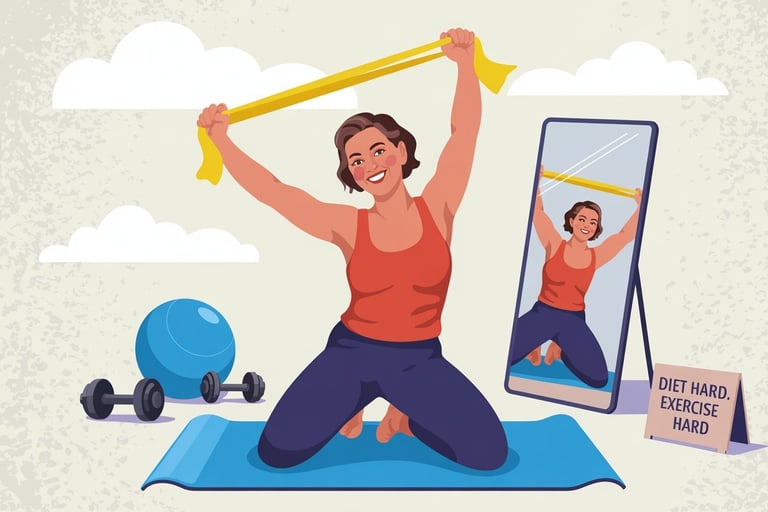FREE AI Analytics Tool for Health Reports and Scans available.
Your Smart Workout Guide to Thriving Through Perimenopause
Feeling lost and low on energy during perimenopause? This friendly guide offers a simple, science-backed workout plan focused on strength, cardio, and flexibility to help you feel strong, vibrant, and in control.
FITNESS AND EXERCISE
8/15/20254 min read
Today, I want to talk about something that's on so many of our minds: perimenopause and how to move through it with strength and grace. We’re going to talk about what it is, and most importantly, how a smart, supportive workout plan can be one of your best allies.
I've had so many women come to me feeling bewildered by the changes happening in their bodies. They'll say, "I feel sluggish," or "My energy is all over the place," and "I'm not as strong as I used to be." And yes, I've felt it too. I remember hitting my late 40s and feeling like my old running routine just wasn't cutting it anymore. My body felt different, and I knew I needed to approach my fitness in a new way.
This isn't about pushing ourselves to the breaking point. It's about a gentle, yet powerful, conversation with our bodies. Think of this as me sharing what I’ve learned—from a place of friendly professionalism and personal experience—to help you feel your best.
What is Perimenopause, Exactly?
Let's clear this up first, because the term is often misunderstood. Perimenopause literally means "around menopause." It's the transition period leading up to menopause, which is officially defined as 12 consecutive months without a menstrual period. This transition can last anywhere from a few years to over a decade.
The friendly science: During this time, the hormones estrogen and progesterone are fluctuating like crazy. This is what's responsible for the hot flashes, mood swings, and sleep disturbances many of us experience. These hormonal shifts also have a direct impact on our metabolism, bone density, and muscle mass, which is why a thoughtful workout plan is so incredibly important right now.
How to Plan a Perimenopause Workout: A Gentle, Smart Approach
Your old "go hard or go home" philosophy might not be serving you anymore, and that's okay. We need to be more strategic and kinder to our bodies. Here’s a plan that I’ve seen work wonders, combining different types of movement to support your health from every angle.
1. Prioritize Strength Training: Your Anti-Aging Powerhouse
This is probably the single most important type of exercise you can do right now. As we age, we naturally lose muscle mass, and those fluctuating hormones accelerate the process. Strength training helps you build and maintain that precious muscle.
A personal anecdote: For years, I just ran. I thought cardio was the be-all and end-all. When perimenopause hit, I started incorporating two days of strength training a week—bodyweight exercises, light dumbbells, even resistance bands. It didn’t take long to notice a difference. My back felt stronger, my joints were less achy, and I felt more capable in my everyday life, like hauling groceries or lifting my suitcase.
The friendly science: Strength training boosts your metabolism because muscle tissue burns more calories at rest than fat tissue does. It also helps improve your bone density, which is critical as declining estrogen levels can increase our risk of osteoporosis. It’s a powerful investment in your future health.
2. Embrace Gentle Cardio: For Heart and Mind
Cardiovascular exercise is still vital, but you don’t need to be running marathons. Think of it as a way to support your heart, manage stress, and boost your mood. The key is to listen to your body.
My advice: Aim for three to four days of moderate cardio a week. This could be a brisk walk with a friend, a bike ride, a swim, or a dance class. The goal isn't to exhaust yourself, but to get your heart rate up and feel good. On days when you feel low on energy, a gentle walk is more than enough.
3. Don’t Forget Flexibility and Mobility
This is the part many of us skip, but it's essential for preventing injury and keeping us feeling limber and agile. Stretching, yoga, and Pilates are fantastic for improving your range of motion and reducing joint stiffness, which can become more common during perimenopause.
A tip I love: I started doing 15 minutes of gentle yoga or stretching every morning. It’s not a full workout, but it’s a beautiful ritual that helps me check in with my body. It has made a surprising difference in my posture and how I feel throughout the day.
Putting It All Together: A Sample Weekly Plan
Here’s a simple, non-intimidating way to structure your week. This is just a suggestion—adjust it to fit your life!
Monday: Strength Training (e.g., bodyweight squats, lunges, push-ups, light weights)
Tuesday: Gentle Cardio (e.g., a brisk 30-minute walk)
Wednesday: Rest or Active Recovery (e.g., gentle stretching or a leisurely walk)
Thursday: Strength Training
Friday: Gentle Cardio
Saturday: Flexibility/Mobility (e.g., a yoga class or deep stretching)
Sunday: Rest or Gentle Walk
This season of life is a time of incredible change, but it can also be a time of profound self-discovery and strength. By listening to your body and adopting a workout plan that truly supports you, you can navigate this transition feeling powerful, vibrant, and completely in control. Remember, you've got this. We're in this together.
Disclaimer: This article is for informational purposes only and is not a substitute for professional medical advice, diagnosis, or treatment. Always seek the advice of a qualified healthcare professional with any questions you may have regarding a medical condition.


Address
Blk 8 Cantonment Close
SIngapore